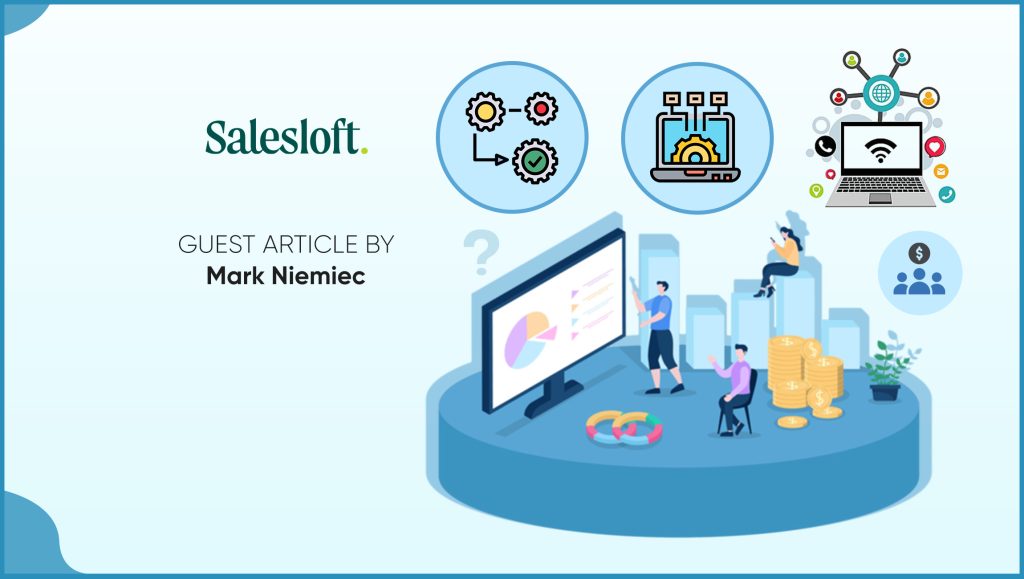B2B sales teams are surrounded by AI. Tools analyze calls, surface buyer signals, and generate task lists. But in our recent 2025 Sales Skill Gaps report, we found that 94% of sellers still manually prioritize their day.
The tech is there. The behavior isn’t.
That’s the real gap. And it’s costing companies more than productivity. It’s eroding the ROI of every technology decision sales leaders make.
According to GartnerⓇ, “By 2027, median sales technology spending will exceed $10,000 per seller per year as B2B sales organizations shift spending from additional headcount to AI and hyperautomation to hit revenue growth targets.”* And yet, 61% of sellers still don’t trust AI recommendations enough to act on them.
That disconnect is holding teams back from realizing the upside. In our 2025 Revenue Processes Benchmark Study, 59% of companies cited improved win rates as a primary benefit of using AI to recommend next steps, and 42% reported accelerated sales cycles. The potential is real. But until sellers trust what they’re being told and understand why it matters, it won’t translate into consistent results.
This isn’t just a feature gap. It’s a behavior and trust gap. And it’s widening.
AI alone doesn’t change how people work. Systems do.
I’ve led sales teams through plenty of technology rollouts. Some that worked, and others that never got off the ground. The difference has never been the tool itself. It’s whether the system supporting that tool drives behavior that sellers actually believe in.
At Salesloft, we built an AI-powered prioritization engine directly into our daily workflows. But adoption didn’t happen overnight. It wasn’t enough to prioritize tasks for sellers. We had to show them why each insight mattered, how it was tied to buyer signals, and how acting on it would impact their pipeline velocity, meeting rates, and deal outcomes.
We tagged each task with the specific signal that triggered it, like a prospect leaving a review on G2, opening a contract in DocuSign, revisiting a pricing page, or viewing a piece of content in Seismic. That level of transparency helped reps connect the dots. It made the system feel like a smart assistant, not just another algorithm pushing generic tasks.
When sellers can connect the recommendation to a result, the trust grows. When they can’t, the system gets ignored.
One sales director in our Skills Gap survey put it simply: “The problem is that they could be so much better at using automation or AI stuff to help them with their processes.”
The tools aren’t the problem. The disconnect is understanding.
Execution isn’t a slogan. It’s a system of habits.
When I say “execution,” I’m not talking about hustle or charisma. I’m talking about consistency.
Execution means reps know where to spend their time, which signals to trust, how to multi-thread early, and how to navigate a deal with precision from first call to close. It means managers can trust the process because it’s repeatable, not reliant on talent alone.
But in our survey, 40% of sellers said they frequently deviate from their sales process, and only 20% of managers believe deals follow a repeatable methodology. That’s not a gap. It’s a structural risk. It means coaching is reactive, forecasting is unreliable, and sellers are guessing when they should be closing deals.
Inside our org, we follow a 13-week cadence to keep teams aligned, but we don’t just rely on process. We lean on AI to surface real-time insights that help leaders understand where to lean in. It’s no longer about waiting for end-of-quarter reports to spot risks or coaching gaps. With tools like Command Center, sales leaders can see what’s happening in the quarter and act fast enough to change the outcome. We use AI to identify patterns across pipeline health, rep activity, and deal progression so managers can coach early, prioritize better, and shift strategy when it matters most.
Consistency isn’t an accident. It’s a rhythm. And tech should reinforce that, not complicate it.
Read More: SalesTechStar Interview with Yuval Kesten, Chief Product Officer at HoneyBook
Sellers don’t resist AI. They resist irrelevance.
The AI itself isn’t what sellers push back on. It’s the way it’s implemented. If the system tells them to follow up with an account but doesn’t explain why, or if the recommendation doesn’t reflect the nuance of their deal, they’ll ignore it.
Gartner predicts, “By 2027, 95% of sellers’ research workflows will begin with AI (whether they choose to or not), up from less than 20% in 2024.”*
But right now, most reps still rely on gut feel. In our research, 43% of sellers prioritize engagement based on personal judgment, not buyer signals.
The intent behind AI is good. But if we don’t bridge the trust gap with explainability, we’ll keep investing in tech that never gets used.
Sellers, especially in complex deals, want to know:
- Why am I being asked to do this?
- How does this help move the deal forward?
- What signal triggered this insight?
The more context we provide—what triggered a suggestion, what outcome it’s tied to—the more likely it is that sellers act. Without that context, even the best tech gets tuned out.
This is personal for me. I spent two years as a buyer to figure out why deals stall.
Earlier in my career, I moved into a buyer role for two years. I wanted to understand what actually drives purchase decisions. And here’s what I saw:
- Most sellers don’t understand how their customer makes money.
- They pitch products, not relevant solutions to buyers’ actual challenges.
- And they miss the signals that tell you whether a deal is real or about to go sideways.
That’s what shaped my conviction: sellers need more than enablement. They need business acumen. They need systems that guide the right actions and make that behavior repeatable.
I’ve seen firsthand what happens when sellers chase the wrong deals, miss risks, or waste time on low-probability accounts. That’s not a motivation problem. It’s a system design problem.
Tech isn’t the problem. But it’s often part of the noise.
Reps in our survey told us they feel overwhelmed, not lazy. Many are operating across disconnected tools, with limited time to onboard new ones or trust what they’re being told. One territory sales manager said: “Lack of understanding with technology and the benefits it provides over the long term is a problem.”
So yes, AI can and should free up time. But only if it actually simplifies the work, not adds layers to it.
Across our sales motion, we’ve reduced friction by integrating AI insights directly into workflows sellers already use. No context-switching, no added dashboards. Simplicity drives adoption. Adoption drives impact.
The future of sales isn’t just AI-powered. It’s behavior-aligned.
If you want your tech investment to deliver real impact:
- Explain the “why” behind AI recommendations
- Build trust by connecting insights to outcomes
- Reinforce process adherence without rigidity
- Coach early, often, and with data, not just instincts
- Make execution frictionless for reps, not forced upon them
Every CRO is being asked the same question right now: You’ve invested in AI, so where’s the impact? If your team doesn’t trust the system or change their behavior, the answer will always come up short.
The best sales teams won’t win because they bought flashier tools. They’ll win because they built better systems. Ones that earn trust, drive consistency, and make execution feel inevitable.
*Gartner, Innovation Guide for Generative AI in Sales, February 2025. GARTNER is a registered trademark and service mark of Gartner, Inc. and/or its affiliates in the U.S. and internationally and is used herein with permission. All rights reserved.
Read More: Optimizing Omnichannel Support Strategies for CX Success






















